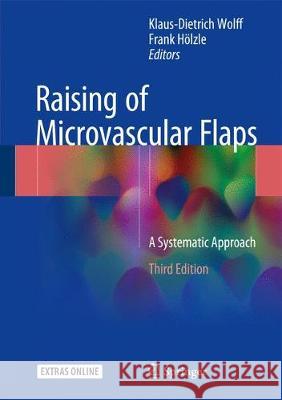Raising of Microvascular Flaps: A Systematic Approach » książka



Raising of Microvascular Flaps: A Systematic Approach
ISBN-13: 9783319536699 / Angielski / Twarda / 2017 / 320 str.
Raising of Microvascular Flaps: A Systematic Approach
ISBN-13: 9783319536699 / Angielski / Twarda / 2017 / 320 str.
(netto: 404,82 VAT: 5%)
Najniższa cena z 30 dni: 424,07 zł
ok. 20 dni roboczych.
Darmowa dostawa!
- Clearly illustrated with over 112 color illustrations to show all aspects of surgeries.
Introduction.- Radial forearm flap.- Lateral arm flap.- Anterolateral thigh / Vastus lateralis flap.- Latissimus dorsi flap.- Scapular flap.- Fibula flap.- Iliac Crest Bone Flap.- Anterolateral Thigh Perforator Flap.- Soleus Perforator Flap.- Deep inferior epigastric artery perforator flap (DIEAP-flap).-Rectus Abdomins Flap.- Radialis Flap.- Suralis Medialis Flap.
Klaus-Dietrich Wolff has been Professor and Head of the Department of Maxillofacial Surgery, Klinikum rechts der Isar, Technische Universität München (TUM), Munich, Germany, since 2007. After studying medicine and dentistry at FU Berlin, Professor Wolff completed his PhD in both subjects in 1987 and acquired his postdoctoral teaching qualification (habilitation) in 1994. Subsequently he was appointed adjunct professor at FU Berlin in 1999. This was followed by a position at Ruhr University Bochum, where he held the Chair of Oral Surgery and Plastic Facial Surgery from 2000 to 2007 and the post of medical director from 2004 to 2007. He moved to TUM in 2007. Professor Wolff researches in the area of plastic reconstructive facial surgery with the aim of improving the microsurgical transfer of tissue through a better understanding of the construction, physiology, and healing of tissue transplants. He is working on an extracorporal perfusion system intended to expand the scope of reconstruction even in the most difficult situations; moreover, he developed the national guidelines for the treatment of oral cavity carcinoma. He has been a recipient of the Martin Wassmund Award from the German Society of Maxillofacial Surgery.
Frank Hölzle is Chairman, Full Professor, and Head of the Department of Oral and Maxillofacial Surgery at the University Hospital of RWTH University Aachen, Germany. He was previously Vice Chairman and Assistant Professor at the Department of Oral and Maxillofacial Surgery, Klinikum rechts der Isar, Technische Universität München (TUM), and prior to that Vice Chairman at the Department of Oral and Maxillofacial Plastic Surgery at Ruhr University Bochum, both periods under the leadership of his mentor Professor Klaus-Dietrich Wolff. Professor Hölzle studied medicine and dentistry at the Free University of Berlin, the Humboldt University of Berlin, the University of Glasgow, and University College London Medical School from 1989 to 1998. He was recognized as a medical specialist for oral and maxillofacial surgery in 2002, and in 2005 he achieved additional qualification as a plastic and reconstructive face surgeon. In 2006, he received his venia legendi for oral and maxillofacial surgery and also became a Fellow of the European Board of Oral & Maxillofacial Surgeons. Professor Hölzle is especially known for his work in the field of plastic facial reconstruction, and in 2007 he received the Martin Wassmund Award from the German Society of Maxillofacial Surgery for his research work on monitoring and improvement of the perfusion of microsurgical flaps and development of retrograde perfusion for perforator flaps in the head and neck.
This book provides all who are involved in microsurgical tissue transfer, including plastic surgeons, ENT surgeons, trauma surgeons, and oral and maxillofacial surgeons, with all the knowledge they will need in daily practice. The new third edition continues with the didactic principle of splitting up complex surgical procedures into a series of simple steps, guided by clearly defined donor site-specific landmarks. For each flap, an anatomically based system of step-by-step procedures is proposed that best combines simplicity, safety, and reliability for successful flap harvesting. Photographs of each step are accompanied by schematic color drawings to enhance understanding of the anatomy. Surgical techniques are also shown in every detail in supplementary videos available online. Additional features in this edition include highly useful modifications of elevation of the radial forearm flap as well as new chapters on the rectus abdominis flap, a reliable option for covering deep and extended defects, and the medial sural perforator flap. Like the previous editions, the book will serve as a quick source of focused and straightforward information valuable for any reconstructive surgeon.
1997-2024 DolnySlask.com Agencja Internetowa
KrainaKsiazek.PL - Księgarnia Internetowa









